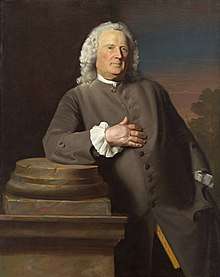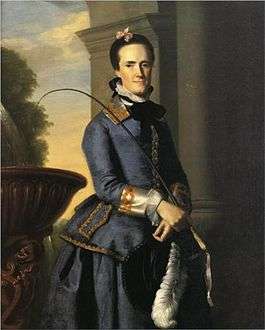Epes Sargent (soldier)
Epes Sargent (July 12, 1690 – December 6, 1762) was an American soldier and landowner from Gloucester, Massachusetts.[1]
Epes Sargent | |
|---|---|
 Portrait of Sargent by Copley, 1760 | |
| Representative of the General Court of Massachusetts | |
| In office 1744–1744 | |
| Personal details | |
| Born | 12 July 1690 Gloucester, Massachusetts |
| Died | 6 December 1762 (aged 72) Salem, Massachusetts |
| Spouse(s) | Esther McCarty
( m. 1720; died 1743)Catherine Winthrop
( m. 1744; |
| Relations | Daniel Sargent (grandson) Henry Sargent (grandson) Lucius Manlius Sargent (grandson) Judith Sargent (granddaughter) Winthrop Sargent (grandson) William Sargent (grandson) John Sargent (grandson) Winthrop Sargent (grandson) |
| Children | 16, including Daniel, Paul, John |
| Parents | William Sargent Mary Duncan |
Early life
Sargent was born on July 12, 1690 in Gloucester, Massachusetts. He was the seventh of fifteen children born to William Sargent II (1659–1707), who came to Gloucester before 1678, and Mary Duncan (d. 1724),[2][3] daughter of Peter Duncan and step-granddaughter of Samuel Symonds, deputy Governor.[4]
His maternal grandparents were Mary Eppes (1629–1692) and Peter Duncan (1629–1716), who emigrated from England to Massachusetts. His paternal grandfather was William Sargent (b. c. 1610) from Exeter, England.[4]
Career
Sargent was one of the largest landholders in Gloucester.[5] He served as a colonel of militia before the Revolutionary War and was a justice of the general session court for more than thirty years.[6]
In 1744, he was Gloucester's representative in the General Court of Massachusetts.[3]
In 1760, two years before his death, he had his portrait painted by John Singleton Copley.[5]
Personal life
_(14597859800).jpg)

On April 1, 1720, he married Esther McCarty (1701–1743), daughter of Florence McCarty, one of the founders of the first Protestant Episcopal society in New England.[3] Before her death, they were the parents of:[3]
- Epes Sargent (1721–1779), who married Catherine Osborne (1722–1788), daughter of Hon. John Osborne.[4] He was the great-grandfather of Epes Sargent (1813–1880).
- Esther Sargent (1722–1745), who married Col. Thomas Goldthwaite (1718–1799).[4][7]
- Ignatius Sargent (b. 1724)[4]
- Thomas Sargent (1726–1727), who died young.[4]
- Winthrop Sargent (1727–1793), who married Judith Saunders (1731–1793)[4]
- Sara Sargent (1729–1792)[4]
- Daniel Sargent Sr. (1730–1806), a successful merchant who was referred to as the "merchant prince". He married Mary Turner (1743–1813).[8]
- William Sargent (1733–1736), who died young.[4]
- Benjamin Sargent (b. 1736)[4]
- Mary Ann Sargent (b. 1740), who died in infancy.[4]
After her death, he married Catherine (née Winthrop) Brown (1711–1781), a widow of Samuel Brown, on August 10, 1744 and moved to Salem, Massachusetts. She was the daughter of Ann Dudley and John Winthrop (1681–1747). Her maternal grandfather was Gov. Joseph Dudley and her paternal grandfather was Wait Winthrop, son of Gov. John Winthrop the Younger and grandson of Gov. John Winthrop, both Governors of the Massachusetts Bay Colony. Together, they were the parents of:[3]
- Paul Dudley Sargent (1745–1828), a noted Revolutionary War hero.[4]
- Ann Sargent (1746–1747), who died in infancy.[4]
- John Sargent (1750–1824),[4] a Loyalist during the Revolution.[9]
Sargent died on December 6, 1762 in Salem, Mass,[6] and his remains were removed to Gloucester for burial.[10]
Descendants
His grandchildren included Daniel Sargent (1764–1842), a politician who was close friends with President John Quincy Adams,[11] Henry Sargent (1770–1845), a painter, and Lucius Manlius Sargent (1786–1867), the temperance advocate, Judith Sargent Murray (1751–1820), the poet and advocate for women's rights, and Winthrop Sargent (1753–1820), Governor of Mississippi Territory.[12]
The artist John Singer Sargent is a descendant through Epes's son, Winthrop.
See also
References
- Farrell, Betty (1993). Elite Families: Class and Power in Nineteenth-Century Boston. SUNY Press. ISBN 9780791415931. Retrieved 23 August 2017.
- Emma Worcester Sargent and Charles Sprague Sargent. Epes Sargent of Gloucester and His Descendants. Boston,
- Cutter, William Richard (2000). Genealogical and Personal Memoirs: Relating to the Families of Boston and Eastern Massachusetts. Genealogical Publishing Com. ISBN 9780806345499. Retrieved 24 August 2017.
- Sheppard, John Hannibal (1871). Reminiscences of Lucius Manlius Sargent: With an Appendix Containing a Genealogy of His Family, and Other Matters. D. Clapp & son. p. 27. Retrieved 24 August 2017.
- "Epes Sargent". www.nga.gov. National Gallery of Art, Washington, DC. Archived from the original on 24 August 2017. Retrieved 23 August 2017.
- Sargent, Winthrop (1920). Colonel Paul Dudley Sargent. Philadelphia: Printed for Private Collection. Retrieved 23 August 2017.
- Maine Historical Society (1896). Collections and proceedings. The Society. p. 35. Retrieved 24 August 2017.
- The New England Historical and Genealogical Register. New England Historic Genealogical Society. 1871. p. 210. Retrieved 23 August 2017.
- Sabine, Lorenzo (2009). Biographical Sketches of Loyalists of the American Revolution. Applewood Books. p. 255. ISBN 9781429019538. Retrieved 24 August 2017.
- New England Historic Genealogical Society (1994). The New England Historical and Genealogical Register: Volume 25 1871. Heritage Books. p. 210. ISBN 9780788401251. Retrieved 24 August 2017.
- Nagel, Paul C. (1999). John Quincy Adams: A Public Life, a Private Life. Harvard University Press. ISBN 9780674479401. Retrieved 23 August 2017.
- Sargent, Emma Worcester (1923). Epes Sargent of Gloucester and His Descendants. Houghton Mifflin. Retrieved 23 August 2017.